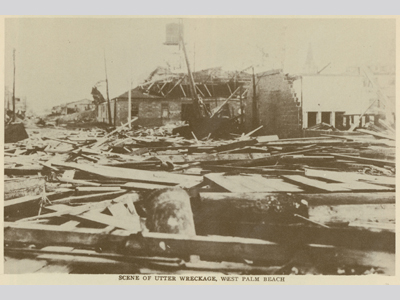This classic Cape Verde-type hurricane was first detected over the tropical Atlantic on September 10, 1928 some 1450 km (900 mi) east of the Caribbean island of Guadeloupe. It likely formed four days earlier between Cape Verde and the coast of Senegal. The system gradually intensified as it moved westward, attaining Category 3 status near the Caribbean on 12 September. It made landfall at Point-a-Pitre, Guadeloupe as a major hurricane that same day. After crossing Guadeloupe, the hurricane continued to strengthen and struck Puerto Rico on 13 September as a powerful Category 5 storm with winds of 256 km/h (160 mph). The mountainous regions of the island saw up to 730 mm (29 in) of rainfall, the highest amount seen there in three decades. The hurricane then moved through the Bahamas as a strong Category 4 hurricane with winds of up to 249 km/h (155 mph). Late on 16 September, it made another landfall near West Palm Beach, FL, still as a Category 4 hurricane with winds of 241 km/h (150 mph) and generating a 3 m (10 ft) storm surge. After directly crossing Lake Okeechobee, the forward motion of the storm turned northeast, bringing it across northern Florida without losing intensity. It then paralleled the coasts of eastern Georgia and the Carolinas, and steadily weakened. Over Virginia, the then tropical storm turned to the northwest, ultimately merging with a low pressure system near Toronto, Canada on 20 September.
This hurricane caused heavy casualties and extensive destruction along its path from the Leeward Islands to Florida. At least 1,500 lives were lost in the Caribbean as a direct result of the hurricane. Nearly every building on the island of Guadeloupe was destroyed and 600-1,200 fatalities were a result of the hurricane. The nearby island of Montserrat lost a great amount of crops during the event, which brought a near starvation situation to the island prior to the arrival of relief. The hardest hit island was Puerto Rico as it took a direct hit from the then Category 5 storm. Residents of the island were well prepared for the storm, however, and as a result the island had a fairly low death toll of about 300. Hurricane-force winds lasting for 18 hours, however, combined with heavy rain, caused disastrous property damage. Tobacco, coffee, sugar, and citrus fruit crops were decimated, with coffee growers losing what had previously appeared to be the most promising harvest in several years and citrus growers losing their entire crop but managing to save most of the tress. Some towns nearest the eye of the storm were almost fully destroyed. In total, several hundred thousand people were rendered homeless in Puerto Rico and an estimated $50 million (1928 USD) in property and crop losses occurred. Coastal South Florida saw catastrophic damage as well, the heaviest in Palm Beach County. Towns greatly affected were Jupiter, Delray, Lake Worth, Pompano, West Palm Beach and Palm Beach, all of which were impacted by the hurricane’s 3 m (10 ft) storm surge. In West Palm Beach, 1,711 homes were destroyed and 6,363 more were damaged. The greatest devastation occurred, however, along the south shore of Lake Okeechobee. There, the 3 m (10 ft) surge washed over the lake’s 1.5-2.4 m (5-8 ft) dikes and flooded an area 120 km (75 mi) wide. At Belle Glade, one of the hardest hit areas, the floodwaters rose to a height of 2.1 meters (7 ft) at a rate of about 25 mm (1 in) per minute. In all, between 2,500 and 3,000 people died making this hurricane the second deadliest hurricane in U.S. History after the 1900 Galveston Hurricane. Total damages from the storm amounted to $100 million (1928 USD) across the Caribbean and the US. Fast Facts:
Sources:
Monthly Weather Review 1928 Hurricane Season NOAA Hurricane History Emanuel, Kerry A. Divine Wind. Oxford: Oxford University Press, 2005. Pp. 117-123. “1928 Okeechobee hurricane.” Wikipedia. 2009. Web. Mitchell, Charles L. “The West Indian Hurricane of September 10-20, 1928.” Monthly Weather Review Vol. 56, No. 9. Weather Bureau. 1928. Web. Fassig, Oliver L. “San Felipe – The Hurricane of Septmber 13, 1928, at San Juan, P. R.” Monthly Weather Review Vol. 56, No. 9. Weather Bureau. 1928. Web. “Memorial Web Page for the 1928 Okeechobee Hurricane.” National Weather Service. 2009. Web. Duedall, Iver W. and John M. Williams. Florida Hurricanes and Tropical Storms. Gainesville: University Press of Florida. 1997. Pp. 15 - 16. “San Felipe Hurricane.” 1870-1879 Atlantic hurricane seasons. Wikipedia. 23 Jan. 2009. Web. |


